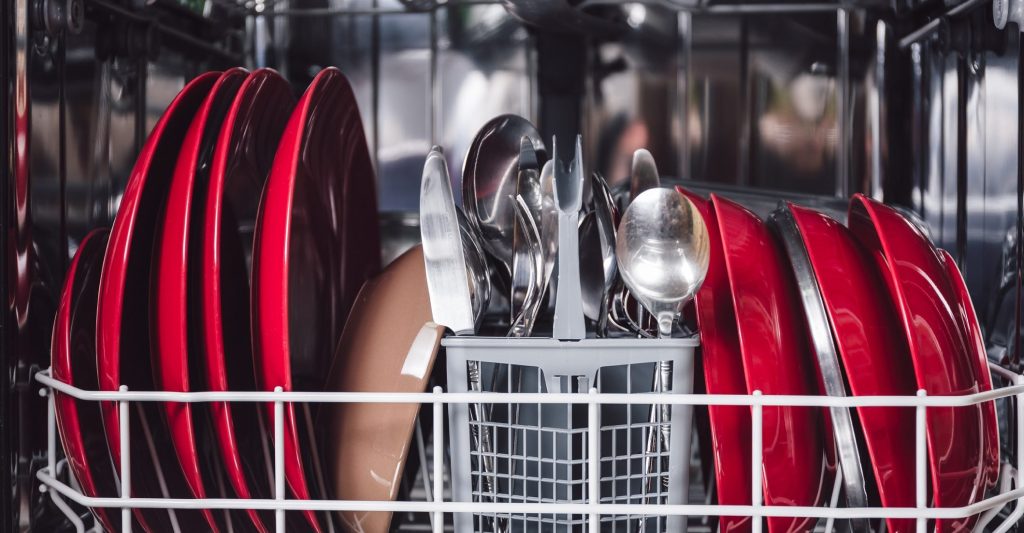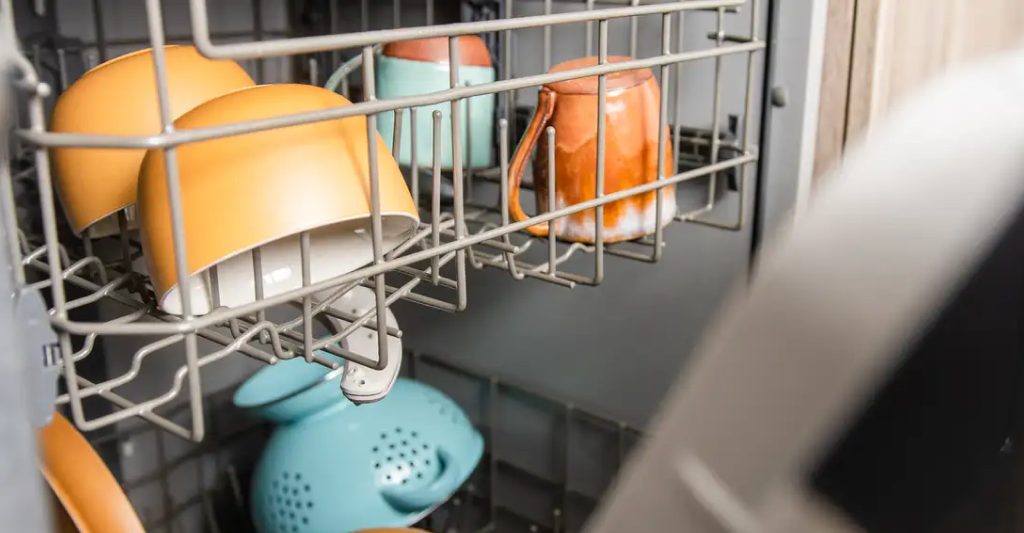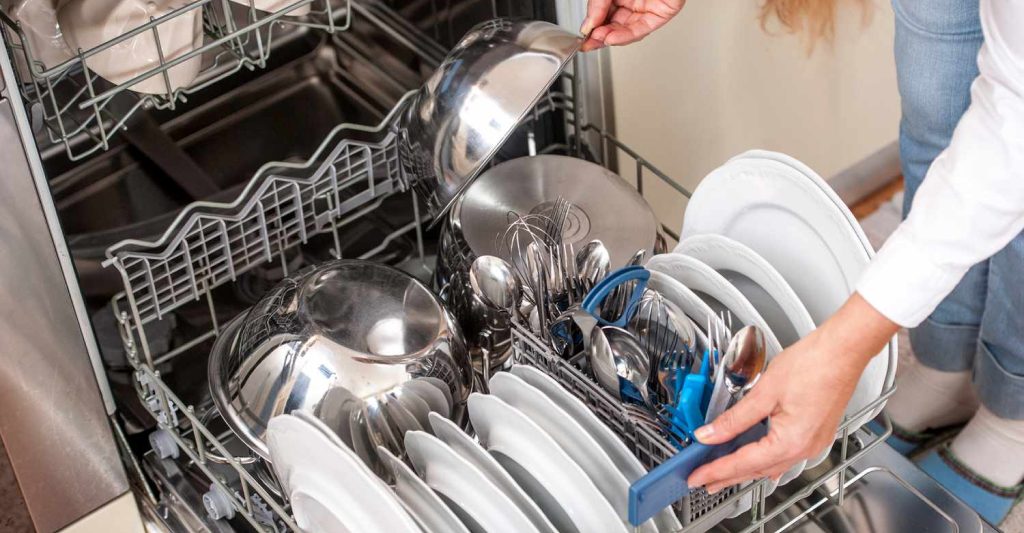
Be sure to arrange all of your dishes so that the filthy sides face the centre. By setting your dishes up this way, you can make sure they are at the right angle to be washed and rinsed by the rotating washer jets that shoot water up or down (or sometimes both). Also, it implies that they will dry properly.
Don’t stuff items in the dishwasher too full
The temptation to sneak in “just one more dish” or “just one more cup” could be strong. By doing this, the jets will be unable to perform their duties effectively. You won’t get as clean of a set of dishes as you might. If you overload your dishwasher, you can even find up having to wash the dishes again, which nobody likes to do.
When placing objects in the dishwasher, be sure they are safe
Not all dirty dishes should be put in the dishwasher. If you choose to put certain larger items in the dishwasher, they could be destroyed. Examples include non-stick pans, knives, fine china, and crystal. Even if it says “microwave safe,” you should still give it some thought. Sadly, there are certain items that you should only hand wash.

Place plastic on the highest shelf
The top rack of your dishwasher is where you should put plastic containers. The dishwasher jet’s very hot water may deform plastic items. In general, the water entering from the top jets is not as hot as the water entering from the bottom shelves.
Begin with the top rack
Start by stacking the top shelf first; it will make your task easier. Cups, mugs, drinking glasses, stemware, plastic objects and containers, tiny bowls, small plates, and big utensils are what experts often advise storing on the top shelf. Place your mugs and cups in a lineal stack. With the dirty side slanted down towards the top shelf jets, stack your small bowls and plates in the spaces between the slots.

Go to the bottom rack
Limiting the items on the bottom shelf of a dishwasher to big bowls, dinner and lunch plates, serving platters, flatware, dishwasher-safe baking dishes, and stainless steel pots and pans is the ideal way to load the bottom shelf.
Ensure that your bowls and plates are positioned in the correct slots with the filthy side towards the jets. Your big dishes, pots, and pans should be placed in the rear, facing down.
In order for the jets to function effectively and for your dishes to be adequately cleaned, make sure that you are not stacking dishes on top of one another. Your dishwasher’s bottom shelf also most likely features a basket with many slots for all of your cutlery.
It’s crucial to avoid overfilling any of the slots while loading this basket. Knives should be packed with the blade facing down (to avoid cutting yourself while unpacking), but forks and spoons will clean more effectively if you pack them handle down.

In the last few paragraphs, you’ve learned the basics of how to load a dishwasher. It’s time to take a closer look at a few of these topics right now. By following these suggestions, you may be sure that you always get the greatest outcomes.
Pre-rinsing your dishes shouldn’t be a concern for you
Did you previously believe that pre-rinsing your dishes was necessary before loading the dishwasher? Simply said, it’s untrue. Indeed, you should scrape off any extra crud from your dishes, but you don’t need to rinse them.
After a complete cycle, if they still aren’t clean, you may need to get your dishwasher serviced. (If your dishwasher is old, you may need to rinse a few dishes since it might not be functioning as well as it formerly did.)
Dishes are actually cleaned more thoroughly in dishwashers if they haven’t been pre-rinsed. Nonetheless, not pre-rising does require you to keep your dishwasher clean. Check out our article on how to clean dishwashers if you want to learn more about this.

There are certain items you should always wash by hand
Be careful when you hand wash your sharp knives if you want them to maintain their edge. Butter knives are OK since they don’t have a sharp blade, but the hot water jets in a dishwasher can dull sharp kitchen knives. You run the danger of your cutting boards and other wooden or plastic goods splitting or warping in the dishwasher.
Non-stick pans may also sustain damage in dishwashers. Washing these objects by hand is preferable than putting them in the dishwasher. Last but not least, you should definitely wash this by hand after you use it if there is anything you wouldn’t want to risk shattering, such as expensive china.
Better methods for loading and unloading your dishwasher exist
There is a more effective dishwasher packing method. When loading your dishwasher, you may accommodate more without overpacking it if you start at the rear of each shelf and work your way forwards. You should empty the bottom rack of your dishwasher first while emptying it to avoid spilling water on your dry dishes.
Run your dishwasher only when it is completely full
Dishwashers may use very little water, but only when they are fully loaded. Wait until the dishwasher is completely loaded before using it, or wash your dishes by hand. It shouldn’t be a problem to keep the dishes there until you have a full load if you have scraped any leftover food from them.
In this post, we wanted to provide you some advice from professionals on how to load a dishwasher properly. You may benefit from these hints and ideas in a variety of ways, including by ensuring that your dishes are always spotless clean and reducing the danger of harm to anything else you put in the dishwasher.
Everything counts, even the sequence in which you load the shelves and the placement of certain dishes. I hope this essay was useful to you.We know how to load a dishwasher properly since we’ve done it a lot of times. In conjunction with one of our routine cleaning services, we may run a load of dishes for you.
Get Instantant Quote Now



